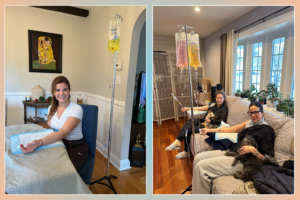
Can You Do IV Therapy at Home?
March 27, 2024
Brief Overview of IV Therapy and Its Rising Popularity
Intravenous (IV) therapy, a method that delivers fluids and nutrients directly into the veins, has seen a significant rise in popularity. Originally confined to hospitals and clinics for treating dehydration, administering medications, and providing nutritional support, IV therapy has expanded its reach. People now seek it out for a wide array of wellness boosts, from hydration to vitamin infusions, highlighting a growing interest in direct-to-system treatments that offer faster and more efficient results than traditional oral methods.
Introduction to the Concept of At-Home IV Therapy Versus Traditional In-Clinic IV Therapy
The question, Can you do IV therapy at home? is becoming increasingly relevant as the demand for more convenient healthcare solutions rises. At-home IV therapy promises the benefits of traditional in-clinic treatments with the added convenience of not having to leave your house, potentially reducing exposure to illnesses and saving time. This service brings professional care into the comfort of your home, where certified healthcare professionals administer IV treatments tailored to individual health needs and wellness goals.
Statement of Purpose
This article aims to explore the feasibility, safety, and considerations of doing IV therapy at home. With the growing interest in at-home medical treatments, it’s crucial to understand how at-home IV therapy compares to its in-clinic counterpart, what safety measures are in place, and what individuals should consider before choosing this option.
What is IV Therapy?

Definition of IV (Intravenous) Therapy
IV therapy is a medical technique that delivers fluids, medications, and nutrients directly into a person’s vein. This method ensures immediate absorption into the bloodstream, offering rapid results for hydration, nutrition, or medical treatment.
Brief Explanation of How It Works and Common Uses
The process involves inserting a small, sterile needle into a vein, typically in the arm, connected to a drip that contains the desired fluid mixture. This direct delivery system is commonly used for hydration, administering vitamins and antioxidants, and treating specific medical conditions that require fast-acting medication.
Types of IV Therapy
- Hydration IV Therapy: Ideal for rapid rehydration, especially after intense physical activity or excessive alcohol consumption.
- Vitamin and Nutrient Infusions: Tailored mixtures of vitamins and minerals to support overall wellness, immune health, and energy levels.
- Medication Administration: For patients who need fast-acting relief or treatment for conditions that cannot be effectively managed orally.
By addressing the question, Can you do IV therapy at home? This article will delve into the possibilities and precautions of at-home IV treatments, offering insights into modern healthcare’s evolving landscape.
III. Benefits of IV Therapy
The benefits of IV therapy are wide-ranging and significant, especially when considering its quick absorption and effectiveness. Unlike oral medications and supplements that must pass through the digestive system—where their potency can be diminished—IV therapy delivers nutrients and medications directly into the bloodstream. This ensures immediate availability to the body’s cells, offering rapid and often more effective results.
Examples of benefits include:
- Hydration: Quickly restores fluid balance after dehydration caused by exercise, illness, or alcohol consumption.
- Nutrient Absorption: Delivers vitamins and minerals directly to the cells, supporting overall health, boosting the immune system, and increasing energy levels.
- Medical Treatments: Provides immediate delivery of medications for conditions that require fast-acting therapeutic levels in the bloodstream.
- Contrast with oral or other forms of therapy: Oral supplements and medications can lose a significant portion of their effectiveness during the digestion process. IV therapy, on the other hand, bypasses the gastrointestinal tract, ensuring that 100% of the administered dose is available for your body to use. This makes it an especially appealing option for individuals looking to maximize the efficiency of their treatments.
- Enhances cellular health: Ensures optimal operation of all bodily functions, leading to improved well-being and vitality.
- Supports long-term health: Works at the cellular level to potentially prevent chronic conditions such as heart disease, cancer, and dementia.
- Infuses vital nutrients: Complements a healthy lifestyle that includes a balanced diet and regular exercise.
IV. At-Home IV Therapy: An Overview

Introduction to at-home IV therapy services: With the question of Can you do IV therapy at home? gaining traction, it’s important to understand what at-home IV therapy entails. This innovative service brings the benefits of IV treatments into the comfort and privacy of your own home, managed and administered by healthcare professionals.
- How these services work: The process typically begins with an initial consultation, often conducted over the phone or online, where a healthcare professional assesses your needs and recommends a personalized IV therapy plan. Once a treatment is chosen, a licensed nurse or healthcare provider visits your home to administer the IV drip, ensuring a professional and safe experience from start to finish.
- The role of professionals in home settings: Professional involvement is crucial in at-home IV therapy to ensure safety and effectiveness. These healthcare providers are responsible for assessing your health history, monitoring the IV administration, and providing care throughout the session, ensuring that the process is as safe and beneficial as possible.
VI. Professional At-Home IV Therapy Services
When considering V therapy at home, it’s essential to select a reputable service. Here’s how to ensure you’re choosing the best provider for your needs:
How to choose a reputable service:
- Look for services that employ certified and experienced healthcare professionals.
- Check reviews and testimonials from previous clients.
- Verify that the service is licensed and insured.
- The process: After selecting a service, the next steps include:
- Selection: Choosing the right IV therapy package based on your health needs and goals.
- Medical Consultation: Undergoing a health assessment to ensure the chosen therapy is appropriate and safe.
- Administration: A healthcare professional will administer the IV drip at your home, monitoring you throughout the process.
What to expect during an at-home IV therapy session:
- The session usually lasts between 30 minutes to an hour.
- You can relax in your own space while the therapy is administered.
- The healthcare professional will ensure your comfort and safety, addressing any questions or concerns you may have.
By opting for professional at-home IV therapy services, individuals can enjoy the benefits of IV therapy with the added convenience and comfort of home, answering the question, “Can you do IV therapy at home?” with a resounding yes, provided that professional guidelines and safety measures are strictly followed.
VII. Safety and Precautions
When exploring the option of at-home IV therapy, safety should be your top priority. While the convenience of receiving IV therapy in the comfort of your home is appealing, understanding and adhering to safety measures is crucial to ensure the treatment is both effective and secure.
Essential safety measures for at-home IV therapy include:
- Sterile Equipment: Always use new, sterile equipment to prevent infections.
- Professional Administration: Ensure that a qualified healthcare professional administers the IV to avoid complications like air embolisms or misplaced IV lines.
- Personalized Treatment: Treatments should be personalized based on a thorough health assessment to avoid adverse reactions.
- Importance of professional involvement: Having a healthcare professional involved in the process from consultation to administration ensures that the IV therapy is appropriate for your health status and goals. Professionals can also manage any unexpected reactions effectively, providing an additional layer of safety.
Signs to watch for professional intervention:
- Unusual pain or discomfort at the IV site
- Signs of infection, such as redness or swelling
- Allergic reactions, including rash, itching, or difficulty breathing
- Any symptoms that feel out of the ordinary during or after the IV therapy session
Recognizing these signs and understanding when to seek professional help can significantly reduce the risks associated with treatments.
IX. Cost and Accessibility
Comparison of the cost of at-home versus in-clinic IV therapy: At-home IV therapy typically carries a higher price tag than its in-clinic counterpart, mainly due to the convenience and personalized service it offers. The added cost covers the travel and time of healthcare professionals who come to your location to provide the service. However, when considering the time saved and the comfort of receiving treatment at home, many find the extra cost justifiable.
Insurance considerations and out-of-pocket costs: Insurance coverage for IV therapy varies significantly by provider and plan. Generally, IV therapy is more likely to be covered if it’s medically necessary and prescribed by a doctor. For wellness-focused treatments, patients often pay out of pocket, it is typically not covered by insurance. It’s important to consult with your insurance provider and the IV therapy service to understand what costs you’ll be responsible for.
Accessibility of at-home IV therapy services across different regions: The availability of at-home IV therapy services can vary widely depending on where you live. Urban and suburban areas are more likely to have access to these services than rural areas. Additionally, some regions may have more stringent regulations governing at-home medical treatments, affecting the availability and scope of services offered.
By considering these factors, individuals interested in at-home IV therapy can make informed decisions about whether this convenient yet potentially more expensive option fits their needs and lifestyle. The key is to weigh the benefits of convenience and personalized care against the cost and to ensure that safety and professional standards are never compromised.
X. Making the Decision: Is At-Home IV Therapy Right for You?
Deciding whether at-home IV therapy is the right choice involves considering several critical factors. The question, Can you do IV therapy at home? requires thoughtful consideration of your health condition, the cost involved, and the convenience factor.
Factors to consider include:
- Health Condition: Your current health status and specific needs are paramount. Some conditions might benefit significantly from direct nutrient or medication administration, while others might not necessitate such measures.
- Cost: While these treatments offer the convenience of not having to travel, it is generally more expensive than treatments received in a clinic. Assess whether the additional cost aligns with your budget and if the benefits outweigh these costs.
- Convenience: The appeal of receiving treatment in the comfort and privacy of your home cannot be understated, especially for those with busy schedules or mobility issues.
Consulting with healthcare professionals for a personalized assessment is crucial to ensure that at-home IV therapy is a safe and effective option for you. A healthcare professional can provide valuable insights into whether this treatment modality suits your specific health needs and circumstances.
Alternatives to at-home IV therapy might include oral supplements, dietary modifications, or in-clinic IV treatments. These alternatives could be more suitable or cost-effective for some individuals, depending on their situation.
XI. Conclusion
Throughout this article, we’ve explored the intricacies of at-home IV therapy, highlighting the benefits, safety precautions, costs, and accessibility issues. The decision to pursue these treatments should not be taken lightly. It requires careful consideration of various factors, including your health needs, financial situation, and the practicality of receiving such treatments at home.
We encourage readers to weigh the pros and cons carefully. While at-home IV therapy offers the convenience and comfort of receiving treatment in your personal space, it’s essential to ensure that the services provided meet the highest standards of safety and professionalism.
Final thoughts on the importance of professional guidance in health decisions cannot be overstated. Consulting with healthcare professionals not only ensures that you are making informed decisions about at-home IV therapy but also safeguards your health and wellbeing. Whether you decide that at-home IV therapy is right for you or choose an alternative treatment path, the guidance of a healthcare professional is invaluable.
Remember, the ultimate goal is to support your health and wellness in the most effective and safe manner possible. Schedule a consultation with Uplift IV Wellness today for New Jersey IV Therapy Services!